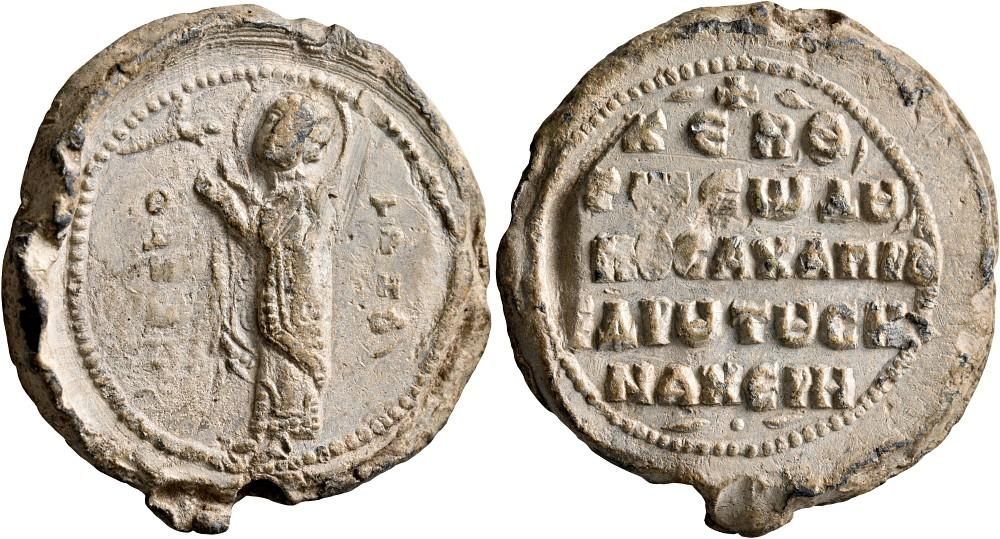Aposachles (Abu Sahl) Senacherim, proedros
Reference Description
The Armenian prince Abusahl
Aposachles (Abu Sahl) Senacherim, proedros, 2nd third of the 11th century. Seal (Lead, 34 mm, 27.40 g, 12 h). Θ / Δ/H/M/H-T/P/H/O, Saint Demetrios, nimbate and wearing himation, standing left, raising his hands in gesture of supplication towards the hand of God. Rev. KЄ R,Θ, / Tω Cω Δ૪, / [A]ΠOCAXΛ ΠPO/ЄΔP૪ T૪ CH/NAXЄPH in five lines. Unpublished, but cf. Cheynet: De Tziliapert à Sébastè, in: SBS 9 (2006), p. 222 = W. Seibt: The Sons of Senek'erim Yovhannēs, the Last King of Vaspurakan, as Byzantine Aristocrats, in: in Revue des Études Arméniennes 37 (2016-2017), p. 119-133, p. 123, for a similar piece. A large and historically interesting seal. A minor scrape on the obverse, otherwise, good very fine.
Aposachles or Abusahl was an Armenian prince and one of the sons of Senek'erim Yovhannēs (Sennacherib-John), the last Artsruni King of the small Kingdom of Vaspurakan, located to the south and southeast of lake Van. He was named after his grandfather, King Abusahl Hamazasp, who ruled in 958/9-968/9. In 1022, Abusahl's father Yovhannēs was forced to cede his kingdom to the Byzantine Empire after he had made the unfortunate choice of joining the anti-Byzantine alliance of the Georgian King Georgi I (998/1002-1027). Although the king is not attested on seals, his wife Chususa and his sons David, Atom, Aposachles and Constantine all appear in the sigillographic record with Byzantine court titles, giving evidence to their elevated status in Byzantine aristocracy. However, none of the family members received any civil or military commands before the 70s of the 11th century, when the disastrous defeat in the Battle of Manzikert shook the Empire. Evidently, any reservations the Byzantines might have had about the loyalty of the former royal family of Vaspurakan were put aside in this time of crisis. Our seal mentions the court dignity of proedros, which represented the first stage of Abusahl’s career, while later seals record his advance to kouropalates and nobellisimos (cf. Seibt pp. 119-133).
Aposachles (Abu Sahl) Senacherim, proedros, 2nd third of the 11th century. Seal (Lead, 34 mm, 27.40 g, 12 h). Θ / Δ/H/M/H-T/P/H/O, Saint Demetrios, nimbate and wearing himation, standing left, raising his hands in gesture of supplication towards the hand of God. Rev. KЄ R,Θ, / Tω Cω Δ૪, / [A]ΠOCAXΛ ΠPO/ЄΔP૪ T૪ CH/NAXЄPH in five lines. Unpublished, but cf. Cheynet: De Tziliapert à Sébastè, in: SBS 9 (2006), p. 222 = W. Seibt: The Sons of Senek'erim Yovhannēs, the Last King of Vaspurakan, as Byzantine Aristocrats, in: in Revue des Études Arméniennes 37 (2016-2017), p. 119-133, p. 123, for a similar piece. A large and historically interesting seal. A minor scrape on the obverse, otherwise, good very fine.
Aposachles or Abusahl was an Armenian prince and one of the sons of Senek'erim Yovhannēs (Sennacherib-John), the last Artsruni King of the small Kingdom of Vaspurakan, located to the south and southeast of lake Van. He was named after his grandfather, King Abusahl Hamazasp, who ruled in 958/9-968/9. In 1022, Abusahl's father Yovhannēs was forced to cede his kingdom to the Byzantine Empire after he had made the unfortunate choice of joining the anti-Byzantine alliance of the Georgian King Georgi I (998/1002-1027). Although the king is not attested on seals, his wife Chususa and his sons David, Atom, Aposachles and Constantine all appear in the sigillographic record with Byzantine court titles, giving evidence to their elevated status in Byzantine aristocracy. However, none of the family members received any civil or military commands before the 70s of the 11th century, when the disastrous defeat in the Battle of Manzikert shook the Empire. Evidently, any reservations the Byzantines might have had about the loyalty of the former royal family of Vaspurakan were put aside in this time of crisis. Our seal mentions the court dignity of proedros, which represented the first stage of Abusahl’s career, while later seals record his advance to kouropalates and nobellisimos (cf. Seibt pp. 119-133).
Provenance
Leu 5 Lot 583
26.10.2019
26.10.2019
See All Items in Category
Citation
“Aposachles (Abu Sahl) Senacherim, proedros,” Armenian Numismatic Research Organization, accessed April 26, 2025, https://armnumres.org/items/show/1239.


